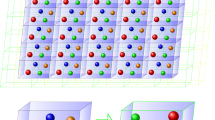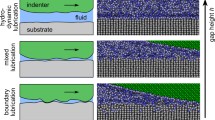Abstract
We measured the dissipation resulting from internal friction in hcp solid 4He at temperatures between 0.8 K and 2.5 K. Solid 4He is contained inside an annular metal cell forming a part of a torsional oscillator. An oscillatory motion of the cell walls applies shear stress on the solid 4He. The resulting shear strain within the solid 4He generates dissipation because of the internal friction. The experimental sensitivity was high enough to detect dissipation caused by internal friction associated with elementary excitations of the solid. At temperatures below 1.6 K, internal friction is associated with diffusion of single point defects responsible for the climb of dislocations. At higher temperatures, the main mechanism of internal friction appears to be associated with phonon exchange between parts of the solid moving relative to each other under the applied shear stress. This particular dissipative mechanism was called “quantum phonon friction” [Popov in Phys. Rev. Lett. 83:1632–1635, 1999]. The physical mechanism associated with this type of friction involves an irreversible transfer of momentum from the phonons to the lattice via an Umklapp process. Our data are in a very good agreement with this model.




Similar content being viewed by others
References
V.L. Popov, Phys. Rev. Lett. 83, 1632–1635 (1999)
D. Aleinikava, E. Edits, A. Kuklov, J. Low Temp. Phys. 162, 464 (2010)
A.B. Kuklov, L. Pollet, N.V. Prokof’ev, B.V. Svistunov, Phys. Rev. B 90, 184508 (2014)
E. Borda, Wei Cai, M. de Koning, Phys. Rev. Lett. 117, 045301 (2016)
E. Kim, M.H.W. Chan, Nature 427, 225 (2004)
D.Y. Kim, M.H.W. Chan, Phys. Rev. Lett. 109, 155301 (2012)
L.S. Levitov, Europhys. Lett. 8, 499–504 (1989)
J. Day, J. Beamish, Nature 450, 853 (2007)
Ye. Vekhov, W.J. Mullin, R.B. Hallock, Phys. Rev. Lett. 113, 035302 (2014)
Z.G. Cheng, J. Beamish, Phys. Rev. Lett. 117, 025301 (2016)
F. Tsuruoka, Y. Hiki, PRB 20, 2702 (1979)
M.A. Paalanen, D.J. Bishop, H.W. Dail, Phys. Rev. Lett. 46, 664 (1981)
I. Iwasa, H. Kojima, PRB 102, 214101 (2020)
A. Haziot, A.D. Fefferman, J.R. Beamish, S. Balibar, Phys. Rev. B 87, 060509(R) (2013)
A. Granato, K. Lucke, J. Appl. Phys. 27, 583 (1956)
T. Markovitz, E. Polturak, J. Low Temp. Phys. 123, 53 (2001)
O. Pelleg, M. Shay, S. Lipson, E. Polturak, J. Bossy, J.C. Marmeggi, H. Kentaro, E. Farhi, A. Stunault, Phys. Rev. B 73, 024301 (2006)
C.A. Burns, N. Mulders, L. Lurio, M.H.W. Chan, A. Said, C.N. Kodituwakku, P.M. Platzman, Phys. Rev. B 78, 224305 (2008)
E.L. Andronikashvili, Zh. Eksp, Teor. Fiz. 16, 780 (1946)
J.E. Berthold, D.J. Bishop, J.D. Reppy, Phys. Rev. Lett. 39, 348 (1977)
D.J. Bishop, J.D. Reppy, Phys. Rev. Lett. 40, 1727–1730 (1978)
X. Mi, A. Eyal, A.V. Talanov, J.D. Reppy, PNAS 113, E3203 (2016)
A. Danzig, Thesis, Technion (2020).
O. Scaly, Thesis, Technion (2018).
E. Livne, A. Eyal, O. Scaly, E. Polturak, J. Low Temp. Phys. 180, 185 (2015)
A. Eyal, E. Livne, E. Polturak, J. Low Temp. Phys. 183, 31 (2016)
Hirth, J. P. & Lothe, J. Theory of dislocations. (McGraw-Hill, 1967).
A. Suhel, J.R. Beamish, Phys. Rev. B 84, 094512 (2011)
A. Kuklov, E. Polturak, N. Prokof’ev and B. Svistunov, https://arxiv.org/abs/2103.08011.
A.I. Volokitin, B.N.J. Persson, H.J. Ueba, Exp. Theor. Phys. 104, 96 (2007)
V.I. Al’shits, V.L. Indenbom, Uspekhi Fiz. Nauk 115, 3 (1975)
A. Haziot, A.D. Fefferman, J.R. Beamish, S. Balibar, Phys. Rev B 87, 060509(R) (2013)
G. Ahlers, Phys. Rev. A 2, 1505 (1970)
I. Iwasa, K. Araki, H. Suzuki, J. Phys. Soc. Jpn. 46, 1119 (1979)
P. Berberieh, P. Leiderer, S. Hunklinger, J. Low Temp. Phys. 22, 61 (1976)
I. Iwasa, H. Suzuki, J. Phys. Soc. Jap. 49, 1722 (1980)
H.J. Maris, Phys. Acoust. 8, 279 (1971)
A.O. Caldeira, A.J. Leggett, Ann. Phys. 149, 374–456 (1983)
Acknowledgements
It is a great pleasure to be able to contribute to the special issue of JLTP honoring David Lee and John Reppy, two of the most prominent members of the Low Temperature Physics community. Their contribution to science is outstanding not only because of the many discoveries they made, but also for turning (with Bob Richardson) the Low Temperature Lab at Cornell into a vibrant hub of low temperature physics which continued as such over several decades. A generation of researchers from all over the world, educated in this lab, went on to spread this tradition of excellence within the Low Temperature Physics community. One of us (E.P.) had the good fortune to spend time in this laboratory and enjoy its special atmosphere. We extend our best wishes to David and John, and may they enjoy good health and many happy events in the years to come.
Funding
At the local level, we thank S. Hoida and L. Yumin for assistance and L. Melnikovsky and A. Kuklov for fruitful discussion. This work was supported by the Israel Science Foundation and by the Technion Fund for Research.
Author information
Authors and Affiliations
Corresponding author
Additional information
Publisher's Note
Springer Nature remains neutral with regard to jurisdictional claims in published maps and institutional affiliations.
Rights and permissions
About this article
Cite this article
Danzig, A., Scaly, O. & Polturak, E. Experimental Study of Classical and Quantum Internal Friction in Solid 4He. J Low Temp Phys 205, 253–262 (2021). https://doi.org/10.1007/s10909-021-02620-9
Received:
Accepted:
Published:
Issue Date:
DOI: https://doi.org/10.1007/s10909-021-02620-9




